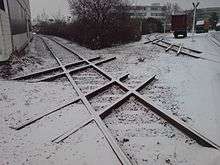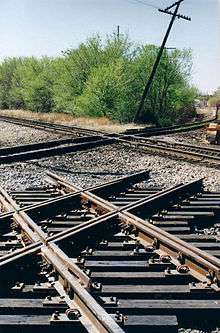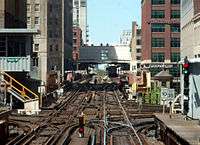Level junction




A level junction (or in the United Kingdom a flat crossing) is a railway junction that has a track configuration in which merging or crossing railroad lines provide track connections with each other that require trains to cross over in front of opposing traffic at grade (i.e. on the level).
The cross-over structure is sometimes called a diamond junction or diamond crossing in reference to the diamond-shaped center. The two tracks need not necessarily be of the same gauge. A diamond crossing is also used as a component of a double junction, like the one illustrated on the right.
The opposite of a level junction is a flying junction, where individual tracks rise or fall to pass over or under other tracks.
Risks
Conflicting routes must be controlled by interlocked signals to prevent collisions.
Level junctions, particularly those of fine angles or near right angles, create derailment risks and impose speed restrictions. The former can occur as the flanges of the wheels are momentarily unsupported and unguided and can slip through the gaps in the rails, and the latter because the assembly contains elements that can break or vibrate loose.
Level junctions are considered a maintenance issue by railroad companies as the inherent gaps tend to be hard on locomotive and rolling stock wheelsets. Switched diamonds partially solve these problems, but introduce new ones.
Examples
Flat crossings are particularly common in the United States where the lines of one company cross the lines of another company, and there is no particular need for the lines to be connected for through traffic.
Three examples of two tracks crossing another two tracks:
- At Rochelle Railroad Park in the United States, the double track Union Pacific Railroad main line crosses the double track BNSF Railway main line forming four diamond crossings altogether at this location.
- At Nagpur, India which is called the Diamond Crossing by the local Railway authorities.[1]
- At Newark flat crossing[2] in the United Kingdom, where the East Coast Main Line and Nottingham to Lincoln Line cross. This is the fastest flat-crossing in the UK, with trains travelling north-south allowed to cross the junction at 100 mph (160 km/h). Protection of the junction is controlled by signalling.
Local transport


Flat crossings appear in some urban passenger rail systems, which can cause delays at peak hours as a train heading in one direction may have to wait for trains heading in another direction to clear the junction before it can cross. The junctions leading onto and off from the Loop of the Chicago 'L' are examples of this problem. The New York City Subway system mostly uses flying junctions, but in a few older parts of the system, flat crossings can still cause delays. Examples include the 142nd Street Junction and the Myrtle Avenue junction.
Level junctions are often found on tram or streetcar networks where lines cross or split. The MBTA in Boston has two of these underground on the Green Line, one where the E Line departs the central subway just west of Copley Station, and another where the C Line and D Line split west of Kenmore Station. While the latter crossing rarely causes delays, the former is at an intersection of four lines and cars often have to wait for others to pass at peak hours. Earlier such splits in Boston (such as the disused crossing west of Boylston Station) were built as flying junctions, but the two level splits were built as level junctions mostly to save money.
Different gauges
A diamond crossing between standard gauge and broad gauge exists at Ararat in Victoria, Australia.
At Porthmadog, in Wales, there is a flat-crossing between the single track standard gauge Cambrian Line and the narrow-gauge Welsh Highland Railway (1 ft 11 1⁄2 in (597 mm), also single track).[3]
In Darby, Pennsylvania, USA, the SEPTA Route 11 line, using Pennsylvania trolley gauge of 5 ft 2 1⁄2 in (1,588 mm), crosses CSX Transportation using standard gauge.[4]
Drawbridge crossing
In Queensland, Australia, a number of flat crossings between narrow gauge (610 mm (2 ft)) cane tramways and main lines (1,067 mm (3 ft 6 in)) have been replaced by drawbridges so that the rails of the main line are completely unbroken by gaps or weak spots: this allows the main line speeds to be raised.[5]

References
- ↑ News Nation. "'Incredible India! What makes the diamond crossing special". News Nation. Retrieved November 10, 2015.
- ↑ http://maps.google.co.uk/maps?ll=53.0906,-0.8048&t=k&z=19
- ↑ Glyn Williams, Tourist and Enthusiast Railways, Wales. Retrieved 2008-03-21.
- ↑ Philadelphia Transit; Streetcars;Route 11 (Kavanaugh Transit Systems)
- ↑ http://www.sa-transport.co.za/trains/sugar_cane_rail/drawbridges.html
External links
![]() Media related to Rail junctions at Wikimedia Commons
Media related to Rail junctions at Wikimedia Commons